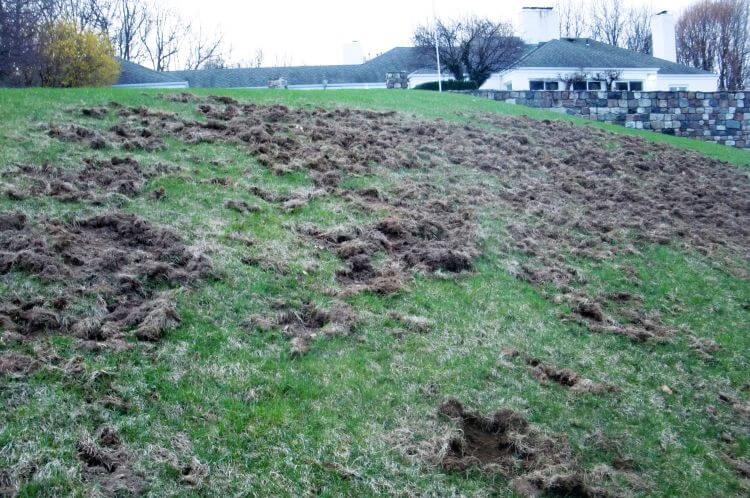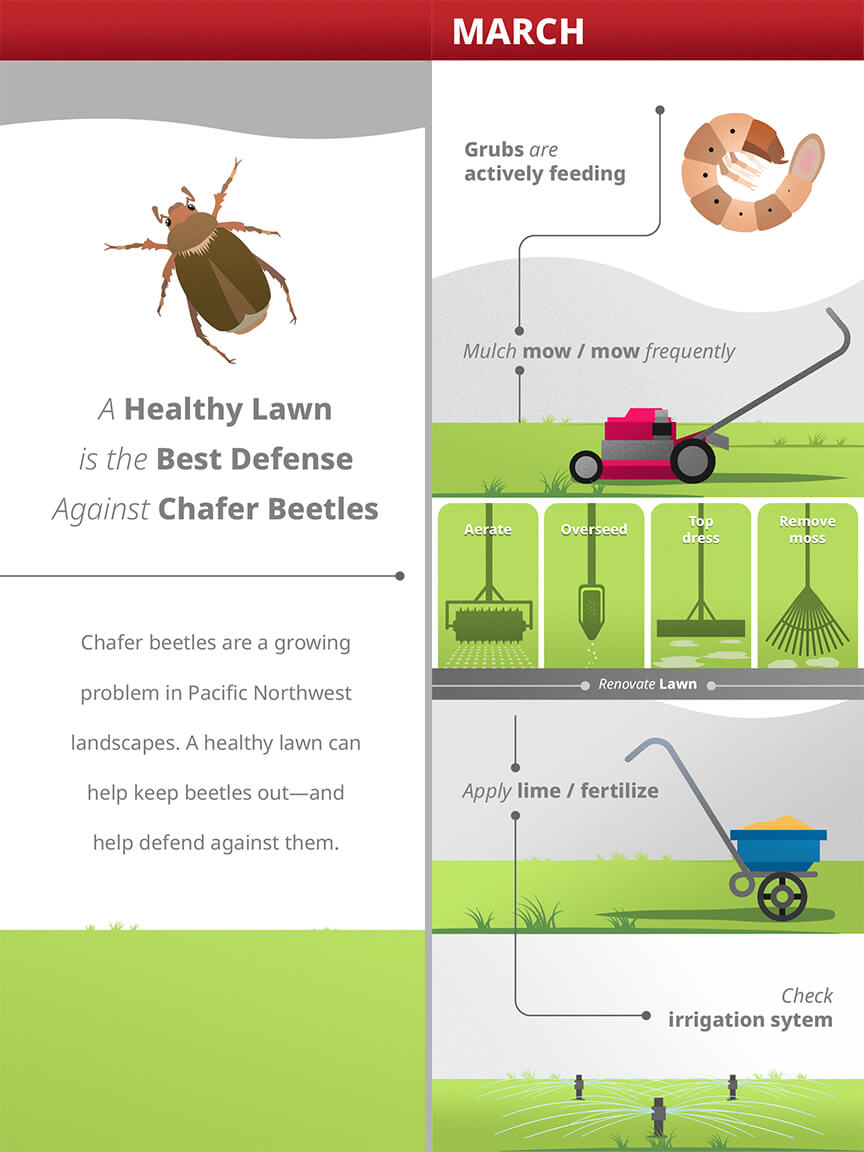
Chafer beetles damage lawns when grubs eat the roots. But the worst damage comes from crows, raccoons and other wildlife looking for chafer beetle grubs. Photo by David Smitley, Michigan State University Entomology.
What’s the deal with chafer beetles?
The European chafer beetle is a serious lawn pest. The grubs feed on lawn roots in spring and fall. This kills the grass and leaves visible dead patches.
The worst damage, however, comes from crows, raccoons, skunks and other wildlife that find the grubs to be a tasty treat. They rip up lawns looking for grubs. Chafer beetles are a growing problem in the Pacific Northwest. They are spreading throughout the Seattle area, causing damage to lawns at homes, parks and golf courses.
How can I prevent chafer beetles from invading?
Take steps now to renovate your lawn and improve its health. “Early research has shown that healthy, well-maintained and watered lawns are the best deterrent for the invasive beetle. European chafers lay their eggs in grass that is dry, unfertilized, and dirt that is compacted,” said Let’s Talk Mercer island.
Here are key steps to take in March.
Aeration, overseeding and topdressing
- Aerate the lawn to build its health. Mechanical aeration removes small cores two to three inches deep into the soil. Aeration has numerous benefits. It reduces soil compaction, improves oxygen content and stimulates root growth. It also improves the uptake of water and fertilizer and reduces water runoff and puddling.
- Overseed to fill in thin spots. We generally overseed after aerating. Overseeding thickens the lawn, so weeds and moss have a difficult time getting established.
- Topdress with a thin layer of compost and sand to protect the seed and build up the soil.
We offer aeration, overseeding and topdressing as part of our natural lawn care services. Contact us now to make an appointment.
Fertilizer and lime
- Fertilize with organic slow-release fertilizer over the course of the growing season to help keep the turf green, thick and healthy.
- Apply lime to improve the pH of the soil. Most Pacific Northwest soils are acidic, which does not promote healthy turf.
We apply fertilizer and lime as part of our natural lawn care services.
Moss control
There are short-term and long-term strategies for moss control.
Short-term strategy
- Treat moss with iron. The Pacific Northwest has ideal conditions for moss. Now is a good time to manage moss. We use iron (ferrous sulphate) to treat moss. It will dehydrate moss but will not kill it. We offer iron treatment for moss as part of our natural lawn care services. Contact us if you would like to schedule moss treatment.
- Remove the moss with a thatching rake once it shrivels up and turns black. If it is not removed, it will continue to spread and grow more thickly. Rake vigorously to loosen the moss and remove it from the lawn. We do not do moss removal.
- Aerate, overseed and topdress following moss removal. This is important to fill in bare spots and help build lawn health. We will return to do this service after the moss is removed.
Long-term strategy
In the long term, the best moss control strategy is to improve the health of the lawn. Our natural lawn care services will help build lawn health. The lawn will not stay healthy unless you water and mow properly (see below). We work in partnership with our clients to keep lawns healthy. We will not use weed and moss killer on lawns that are not maintained properly.
Moss loves to grow in shade and in low-acid or soggy soils. We can help you to:
- Correct drainage problems
- Improve lawn fertility and pH
- Prune your trees to allow more sunlight to reach shady areas
- Work with you to replace the lawn in wet or shady areas with plants that thrive in those environments.
Irrigation and watering
- Check your irrigation system to make sure it is watering the lawn evenly.
- Water once or twice a week throughout the growing season. Aim for about an inch of water per week. According to the Washington Invasive Species Council, “Irrigated lawns have shown resistance to [chafer beetle] damage in the Midwest and on the East Coast.” Here is a short video on how to measure one inch of water.
- Do not allow your lawn to go dormant in summer. If your lawn gets too dry, it can get thin and weak. This provides ideal conditions for chafer beetles, moss and weeds to invade.
We can check and adjust your irrigation system.
Mowing
- Increase mowing height to 2-1/2 to 3 inches. This produces deeper roots, shades out weeds and holds up better to damage. If you cut the grass short, it will be more vulnerable to chafer beetles, allow the invasion of moss and weeds, prevent good root growth and be less resistant to erosion and compaction.
- Mulch mow. When you leave clippings on the lawn, you add organic matter and nutrients. You can mulch mow with a regular mower and leave clippings on the surface to break down. Or use a mulching mower. It blows chopped clippings down to the soil, leaving a clean lawn.
- Mow frequently. If you mow every four to five days instead of every seven days, mowing time can be reduced up to 38 percent when you don’t bag your clippings.
Quick checklist
Here is an infographic with a checklist of steps to take in March to prevent chafer beetles from invading and damaging your lawn. Contact us for help improving your lawn’s health.

